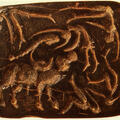"On another seal, No. 510 [in Mackay], a buffalo appears to have attacked a number of people who are lying on the ground around him in every conceivable attitude," writes the excavator Ernest Mackay. "It is undoubtedly the wild rather than the domesticated species that is represented in on this seal, an altogether finer animal which stands 16 to 16.5 hands high at the shoulder. Unlike the domesticated variety, it is very truculent and when wounded is very savage; it was, therefore, a fitting vahana or vehicle for Yama, the god of death.
"The little drama depicted on this seal may represent an










